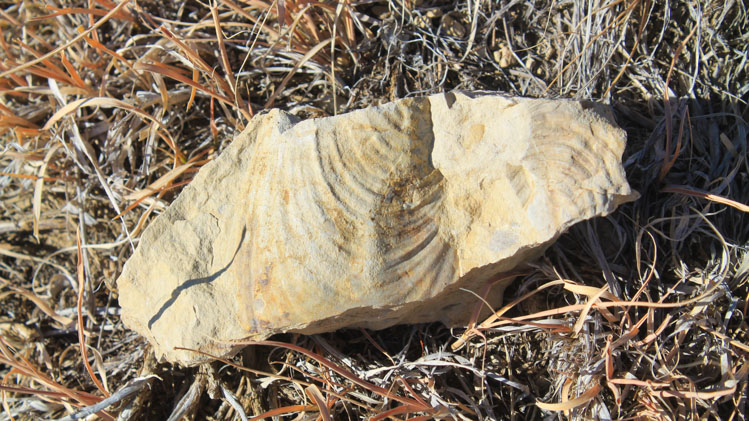The Gift of South Dakota
Subscriptions to South Dakota Magazine make great gifts!
Subscribe today — 1 year (6 issues) is just $29!
Clams of Buffalo Gap
Jun 16, 2021
 |
| Remnant of an ancient sea are sprinkled throughout the Buffalo Gap National Grassland. |
The Great Plains were long ago inundated by a shallow sea called the Western Interior Seaway. Scientists say that marine fossils are evidence of this sea, not that Sasquatch carries a sack of fossils around, scattering them hither and yon to confound the trackers on his tail. You be the judge.
Marine fossils can be found in certain geological formations throughout the Western Interior Seaway region, including the Pierre Shale, which is notoriously fossiliferous. Ancient sea monsters like plesiosaurs, prehistoric sharks and big fish like Ichthyodectes have been plucked from its obsidian mounds. There are also beautiful ammonites (ancient mollusks that resemble a nautilus) and plain old inoceramids (ancient clams).
A portion of the Buffalo Gap National Grassland in the southwest corner of the state has a reputation for ammonite and other fossil finds in scree fields surrounding Pierre Shale and limestone exposures. To get there, take Highway 18 west about a mile and a half past Edgemont, turn right on the 9A, then after about 7 miles, a left on Fall River Road, which will take you into forest land near the Wyoming border. You'll need a map, as BGNG lands are fairly checkerboarded.
The landscape's euphoric undulance is so liberating you can understand how people invested in imposing grids would oversell the people they imported to work them on arability. Time goes soft and loses its linear oomph here. You can almost imagine a cowgirl riding the seaway on a mosasaurus like its name was Tilikum.
I still have much to learn about the art of fossil hunting, probably missing ammonites beneath my feet. Inoceramids are everywhere.
Think of how different your day is from that of your ancestors, say a thousand years ago. Clam (and pre-clam) life hasn't changed much in 70 million years or so. The predators may have changed, from pterodactyls to Italians, but what's that matter to a clam? Clams have always hung out in the sand, waiting for high tide so they can screen floaties with their siphon. That's about it.
Their presence is a reminder of the Western Interior Seaway (or Sasquatch and his bag of fossils) and the epochal changes witnessed by these lands. Will our present human episode leave traces as permanent as those left by these bivalves?
Michael Zimny is a content producer for South Dakota Public Broadcasting and is based in Rapid City. He blogs for SDPB and contributes columns to the South Dakota Magazine website.










Comments